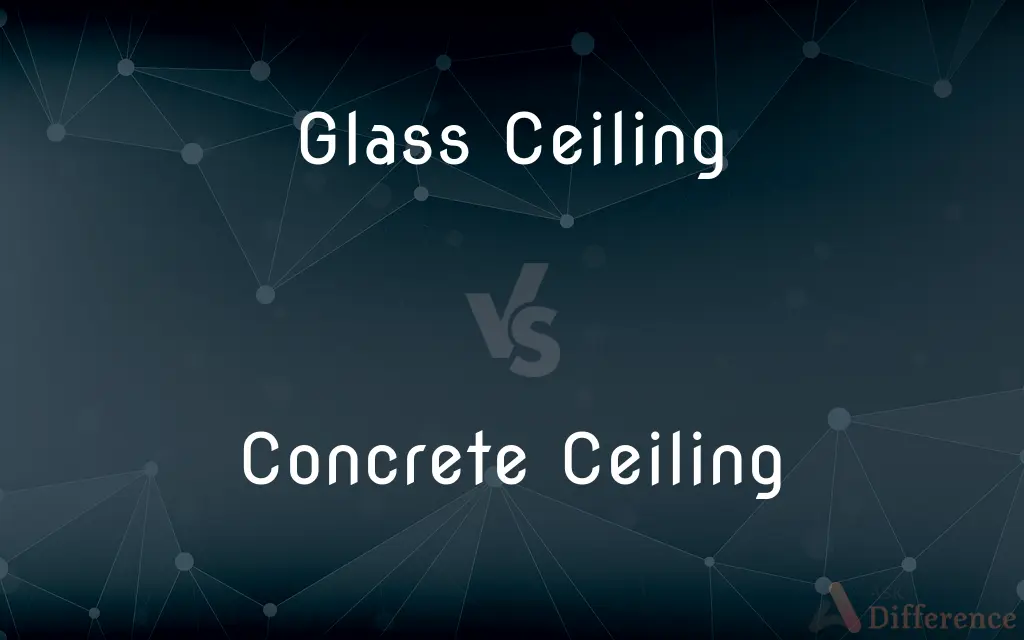Glass Ceiling vs. Concrete Ceiling — What's the Difference?
By Tayyaba Rehman — Published on October 4, 2023
Glass Ceiling refers to invisible barriers women face in professional advancement; Concrete Ceiling refers to even harder-to-break barriers faced often by people of color.

Difference Between Glass Ceiling and Concrete Ceiling
Table of Contents
ADVERTISEMENT
Key Differences
The Glass Ceiling is a metaphorical representation of the unseen, yet unbreachable barrier that keeps women from rising to the upper rungs of the corporate ladder, irrespective of their qualifications or achievements. Conversely, the Concrete Ceiling describes an even more solid, immovable barrier often faced by people of color in professional settings, emphasizing the added layer of racial or ethnic discrimination.
While the Glass Ceiling speaks primarily to gender-based impediments in the workplace, the Concrete Ceiling addresses both racial and gender biases, making it a doubly oppressive barrier for women of color. Both terms illustrate the systemic issues within corporate hierarchies, although the Concrete Ceiling underscores a more pronounced, multi-faceted discrimination.
For many women, the Glass Ceiling is an ever-present obstacle, suggesting that no matter how competent or accomplished they are, there's an intangible limit to their progress. On the other hand, the Concrete Ceiling isn't just about career advancement; it encapsulates broader societal prejudices, suggesting that for some, the barriers are thicker and more evident than mere glass.
In essence, while the Glass Ceiling is a broader concept highlighting gender discrimination, the Concrete Ceiling pinpoints the intersection of race and gender biases. Both concepts underscore the need for systemic change in corporate cultures to achieve true equality.
Comparison Chart
Primary Focus
Gender-based barriers in professional advancement
Racial (and often gender) barriers in professional advancement
ADVERTISEMENT
Permeability
Invisible but significant
More rigid and pronounced
Associated Groups
Predominantly women
Predominantly people of color (especially women of color)
Origin of the Term
Highlighting gender biases in corporate hierarchies
Emphasizing the intersection of race and gender biases
Societal Implications
Represents gender discrimination in the workplace
Represents multifaceted discrimination both in and out of work
Compare with Definitions
Glass Ceiling
An invisible barrier preventing women's upward mobility.
Despite her qualifications, she felt the effects of the Glass Ceiling in her company.
Concrete Ceiling
Symbolizes multifaceted discrimination faced by ethnic minorities.
The Concrete Ceiling is a pressing issue in many corporate hierarchies.
Glass Ceiling
A term denoting gender-based corporate restrictions.
The corporate world is becoming increasingly aware of the Glass Ceiling phenomenon.
Concrete Ceiling
A term denoting the hard-to-break barriers faced by people of color.
Many professionals of color feel the weight of the Concrete Ceiling in their careers.
Glass Ceiling
A metaphorical obstruction to professional progression for women.
The tech industry is notorious for its Glass Ceiling.
Concrete Ceiling
A more pronounced barrier than the Glass Ceiling, emphasizing racial impediments.
Diversity programs aim to dismantle the Concrete Ceiling in various industries.
Glass Ceiling
Represents unspoken limitations on women's career advancements.
Initiatives are being taken to shatter the Glass Ceiling in various sectors.
Concrete Ceiling
Represents compounded racial and gender biases in workplaces.
Women of color often face the dual challenges of the Glass and Concrete Ceiling.
Glass Ceiling
Highlights systemic gender biases in workplaces.
Training programs are addressing the Glass Ceiling issue to promote gender equality.
Concrete Ceiling
Highlights the intersection of race and gender biases in professional settings.
Addressing the Concrete Ceiling requires comprehensive diversity and inclusion efforts.
Common Curiosities
Why is it called the "Concrete" Ceiling?
The term "Concrete" suggests a harder-to-break barrier, emphasizing the pronounced discrimination often faced by people of color.
How is the Concrete Ceiling different from the Glass Ceiling?
The Concrete Ceiling emphasizes the compounded racial and often gender biases, making it a more rigid barrier, especially for people of color.
Is the Glass Ceiling only about gender bias?
Primarily, yes, the Glass Ceiling focuses on gender-based impediments in the workplace.
Do all ethnic minorities face the Concrete Ceiling?
While the term underscores challenges for people of color, experiences can vary based on industry, region, and specific ethnic backgrounds.
Is the Glass Ceiling a global phenomenon?
Yes, the Glass Ceiling is a challenge faced by women across various cultures and regions, although its intensity might vary.
What does the Glass Ceiling represent?
The Glass Ceiling represents invisible barriers women face in professional advancement.
Can men face the effects of the Glass Ceiling?
While the term predominantly addresses women's challenges, men in female-dominated sectors might experience similar barriers.
How can organizations address the Glass Ceiling?
Organizations can promote gender equality, offer mentorship programs, and ensure unbiased hiring and promotion practices.
What initiatives can help break the Concrete Ceiling?
Fostering a culture of inclusivity, addressing unconscious biases, and having diverse leadership can help dismantle the Concrete Ceiling.
Are there industries where the Concrete Ceiling is more pronounced?
Some sectors might exhibit a more pronounced Concrete Ceiling, but its presence can be felt across industries to varying extents.
Share Your Discovery

Previous Comparison
Surname vs. Middle Name
Next Comparison
Finalising vs. FinalizingAuthor Spotlight
Written by
Tayyaba RehmanTayyaba Rehman is a distinguished writer, currently serving as a primary contributor to askdifference.com. As a researcher in semantics and etymology, Tayyaba's passion for the complexity of languages and their distinctions has found a perfect home on the platform. Tayyaba delves into the intricacies of language, distinguishing between commonly confused words and phrases, thereby providing clarity for readers worldwide.
















































